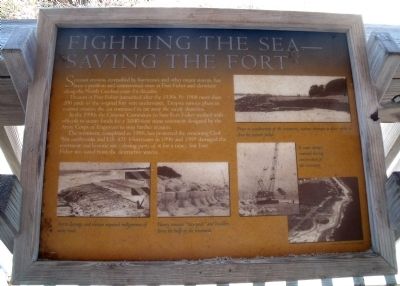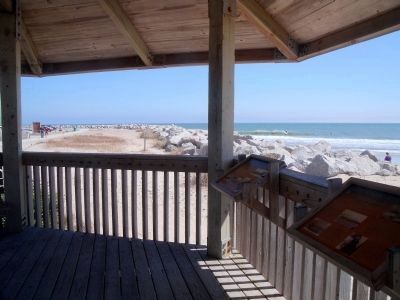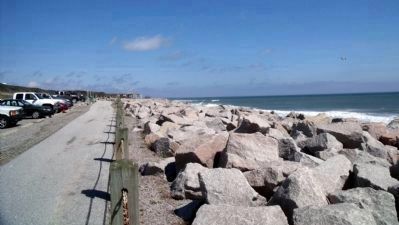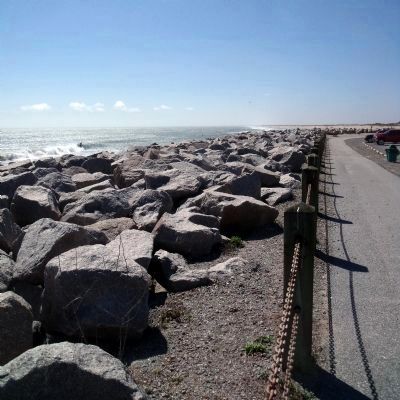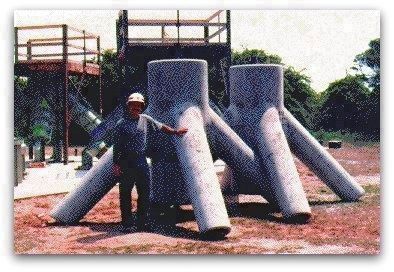Kure Beach in New Hanover County, North Carolina — The American South (South Atlantic)
Fighting the Sea - Saving the Fort
Erosion at Fort Fisher intensified after the 1930s. By 1968 more than 200 yards of the original fort were underwater. Despite various plans to control erosion, the sea continued to eat away the sandy shoreline.
In the 1990s the Citizens’ Committee to Save Fort Fisher worked with officials to secure funds for a 3,040-foot stone revetment designed by the Army Corps of Engineers to stop further erosion.
The revetment, completed in 1996, has protected the remaining Civil War earthworks and U.S. 421. Hurricanes in 1996 and 1999 damaged the revetment and historic site (closing parts of it for at time), but Fort Fisher was saved from the destructive waters.
Erected by Fort Fisher Historic Site. (Marker Number 14.)
Topics. This historical marker is listed in these topic lists: Forts and Castles • Man-Made Features • War, US Civil. A significant historical year for this entry is 1968.
Location. 33° 58.081′ N, 77° 55.162′ W. Marker is in Kure Beach, North Carolina, in New Hanover County. Marker can be reached from Battle Acre Road near Fort Fisher Boulevard South (U.S. 421). This marker is located in the oceanfront gazebo at the "Battle Acre" tour stop. Touch for map. Marker is in this post office area: Kure Beach NC 28449, United States of America. Touch for directions.
Other nearby markers. At least 8 other markers are within walking distance of this marker. Blockade-Running (here, next to this marker); Fort Fisher Monument (about 600 feet away, measured in a direct line); Headquarters of Fort Fisher (about 600 feet away); W.H.C. Whiting (about 800 feet away); Fort Fisher (about 800 feet away); a different marker also named Fort Fisher (approx. 0.2 miles away); Fort Fisher Since 1865 (approx. 0.2 miles away); Capture! (approx. 0.2 miles away). Touch for a list and map of all markers in Kure Beach.
More about this marker. On the upper right is a photo showing that "Prior to the construction of the revetment, various attempts to place rubble to slow the erosion failed."
On the lower left is a photo with the caption, "Storm damage and erosion required realignment of some roads."
On the lower center & right are construction photos with the captions, "Heavy concrete “stay-pods” and boulders form the bulk of the revetment." and "A crane dumps material during construction of the revetment."
Courtesy U.S. Army Corps of Engineers
Also see . . .
1. Fort Fisher. North Carolina Historic Sites entry (Submitted on March 16, 2010, by Bernard Fisher of Richmond, Virginia.)
2. Fort Fisher State Recreation Area. North Carolina State Parks entry (Submitted on March 16, 2010, by Bernard Fisher of Richmond, Virginia.)
Additional commentary.
1. Facts about the seawall at Fort Fisher North Carolina
Jack Biddel was the operator who placed every piece of granite at the Seawall also Dugout underwater for the stay pods that were placed and cut the slope back for the placement of the granite the article can be seen in the Star newspaper with his picture of Biddle they were going to use the crane 2 place the granite but found out quickly they could not do this so Biddle took over and started placing the granite with the trackhoe this is why they were able to complete the job 3 months early there is a picture of mr. Biddle sitting on the rocks with a hard hat on in the newspaper article in the star news paper it was an amazing feat don't only to place the granite what to dig out under water and only be a couple inches difference in height for the stay pods sheathing had to be placed out in the ocean to prevent waves from coming in the machine let's give credit where credit's due Note To Editor only visible by Contributor and editor
— Submitted July 3, 2016, by JACK W Biddle of Currie, North Carolina.
Credits. This page was last revised on February 21, 2021. It was originally submitted on March 16, 2010, by Bernard Fisher of Richmond, Virginia. This page has been viewed 1,313 times since then and 91 times this year. Photos: 1, 2, 3, 4. submitted on March 16, 2010, by Bernard Fisher of Richmond, Virginia. 5. submitted on August 8, 2016, by JACK W Biddle of Currie, North Carolina.
